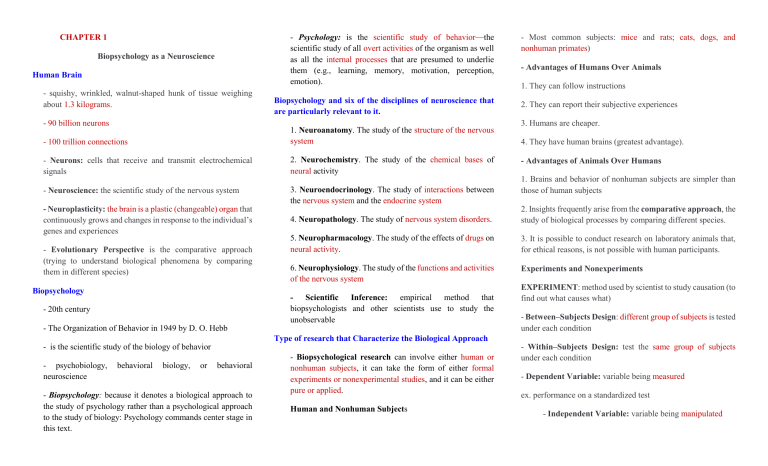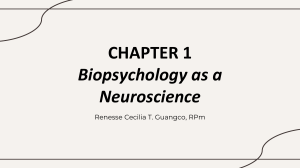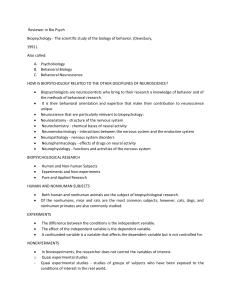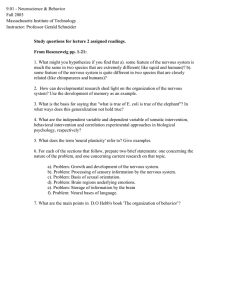
- Psychology: is the scientific study of behavior—the scientific study of all overt activities of the organism as well as all the internal processes that are presumed to underlie them (e.g., learning, memory, motivation, perception, emotion). CHAPTER 1 Biopsychology as a Neuroscience Human Brain - squishy, wrinkled, walnut-shaped hunk of tissue weighing about 1.3 kilograms. - 90 billion neurons Biopsychology and six of the disciplines of neuroscience that are particularly relevant to it. - 100 trillion connections 1. Neuroanatomy. The study of the structure of the nervous system - Neurons: cells that receive and transmit electrochemical signals 2. Neurochemistry. The study of the chemical bases of neural activity - Neuroscience: the scientific study of the nervous system - Neuroplasticity: the brain is a plastic (changeable) organ that continuously grows and changes in response to the individual’s genes and experiences - Evolutionary Perspective is the comparative approach (trying to understand biological phenomena by comparing them in different species) Biopsychology 3. Neuroendocrinology. The study of interactions between the nervous system and the endocrine system - Advantages of Humans Over Animals 1. They can follow instructions 2. They can report their subjective experiences 3. Humans are cheaper. 4. They have human brains (greatest advantage). - Advantages of Animals Over Humans 1. Brains and behavior of nonhuman subjects are simpler than those of human subjects 4. Neuropathology. The study of nervous system disorders. 2. Insights frequently arise from the comparative approach, the study of biological processes by comparing different species. 5. Neuropharmacology. The study of the effects of drugs on neural activity. 3. It is possible to conduct research on laboratory animals that, for ethical reasons, is not possible with human participants. 6. Neurophysiology. The study of the functions and activities of the nervous system Experiments and Nonexperiments - Scientific Inference: empirical method that biopsychologists and other scientists use to study the unobservable - 20th century - Most common subjects: mice and rats; cats, dogs, and nonhuman primates) - The Organization of Behavior in 1949 by D. O. Hebb EXPERIMENT: method used by scientist to study causation (to find out what causes what) - Between–Subjects Design: different group of subjects is tested under each condition Type of research that Characterize the Biological Approach - is the scientific study of the biology of behavior - psychobiology, neuroscience behavioral biology, or behavioral - Biopsychology: because it denotes a biological approach to the study of psychology rather than a psychological approach to the study of biology: Psychology commands center stage in this text. - Biopsychological research can involve either human or nonhuman subjects, it can take the form of either formal experiments or nonexperimental studies, and it can be either pure or applied. Human and Nonhuman Subjects - Within–Subjects Design: test the same group of subjects under each condition - Dependent Variable: variable being measured ex. performance on a standardized test - Independent Variable: variable being manipulated ex. hours of sleep per night - Hypothalamus (a small neural structure at the base of the brain) - Confounded Variable: unintended difference - Coolidge Effect: a copulating male who becomes incapable of continuing to copulate with one sex partner can often recommence copulating with a new sex partner. QUASIEXPERIMENTAL STUDIES - studies of groups of subjects who have been exposed to the conditions of interest in the real world. - Corpus Callosum (the large neural pathway that connects the left and right halves of the brain) Six Major Divisions of Biopsychology 1. Physiological Psychology - study of the neural mechanisms of behavior by manipulating the nervous systems of nonhuman animals in controlled experiments CASE STUDIES - surgical and electrical methods - focused on a single case or subject - Forms: formal experiments or nonexperimental studies - Type: pure or applied - Comparative Research: the study of biological processes by comparing different species. - Generalizability: the degree to which their results can be applied to other cases. PURE AND APPLIED RESEARCH - Pure Research: motivated primarily by the curiosity of the researcher; done solely for the purpose of acquiring knowledge - Applied Research: intended to bring about some direct benefit the humankind - Translational Research: research that aims to translate the findings of pure research into useful applications for humankind - Motor Neurons (neurons that control muscles) ex. Physiological psychologists have studied the contributions of the hippocampus to memory by surgically removing the hippocampus in rats and assessing their ability to perform various memory tasks. ex. Neuropsychologists have shown that patients with alcohol-produced brain damage have particular difficulty in remembering recent events. 4. Psychophysiology - study of the relation between physiological activity and psychological processes in human volunteers by noninvasive physiological recording (electroencephalogram) ex. Psychophysiologists have shown that familiar faces elicit the usual changes in autonomic nervous system activity even when patients with brain damage report that they do not recognize a face. 5. Cognitive Neuroscience - youngest division of biopsychology - study of the neural mechanisms of human cognition, largely through the use of functional brain imaging 2. Psychopharmacology - study of the effects of drugs on the brain and behavior - Psychopharmacologists have tried to improve the memory of Alzheimer’s patients by administering drugs that increase the levels of the neurotransmitter acetylcholine. - Cognition, a term that generally refers to higher intellectual processes such as thought, memory, attention, and complex perceptual processes. ex. Cognitive neuroscientists have used brain-imaging technology to observe the changes that occur in various parts of the brain while human volunteers perform memory tasks. 3. Neuropsychology 6. Comparative Psychology - study of the psychological effects of brain damage in human patients - study of the evolution, genetics, and adaptiveness of behavior, largely through the use of the comparative method - cerebral cortex: is most likely to be damaged by accident or surgery ex. Comparative psychologists have shown that species of birds that cache their seeds tend to have big hippocampi, confirming that the hippocampus is involved in memory for location. - Ethological Research the study of animal behavior in its natural environment. 4. Eye is passively rotated upward by finger, and object is stationary; therefore, retinal image moves up. Object is seen to move down - Evolutionary Psychology (a subfield that focuses on understanding behavior by considering its likely evolutionary origins) Critical Thinking about Biopsychological Claims - Genetics (the study of genetic influences on behavior) How Do Biopsychologists Conduct Their Work? - Converging Operations different approaches are focused on a single problem in such a way that the strengths of one approach compensate for the weaknesses of the others (combined approach). - Thinking Creatively unconventional ways to think in productive, - Critical Thinking process by which the weaknesses of creative thinking are recognized. - Korsakoff’s Syndrome unable to form new lasting memories - Prefrontal Lobotomy—a surgical procedure in which the connections between the prefrontal lobes and the rest of the brain are cut as a treatment for mental illness. - largely caused by the brain damage associated with thiamine (vitamin B1) deficiency. - Prefrontal Lobes are the large areas, left and right, at the very front of the brain. Scientific Inference: How Do Biopsychologists Study the Unobservable Workings of the Brain? - Scientific Inference empirical method that biopsychologists and other scientists use to study the unobservable. Perception of Motion Under Four Different Conditions 1. Eye is stationary, and object is stationary; therefore, retinal image is stationary. No movement is seen. 2. Eye actively rotates upward, and object is stationary; therefore, retinal image moves up. No movement is seen 3. Eye is stationary, and object moves down; therefore, retinal image moves up. Object is seen to move down. - Leucotome surgical device used to cut prefrontal tissue - Transorbital Lobotomy involved inserting an ice pick–like device under the eyelid, driving it through the orbit (the eye socket) with a few taps of a mallet, and pushing it into the frontal lobes, where it was waved back and forth to sever the connections between the prefrontal lobes and the rest of the brain - Psychosurgery (any brain surgery, such as prefrontal lobotomy, performed for the treatment of a psychological problem.



